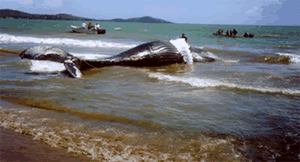The
Caribbean Stranding Network
On of the efforts done in Puerto
Rico to preserved and take care of endangered species has been
offered by the Caribbean Stranding Network.
The purpose of this effort is to understand the mortality and stranding
problems of endangered marine mammals in Puerto Rico. This network
required a new integrated and funded program in which all the efforts
and talent
from all the responsible and interested people in the conservation
of endangered species. One of the objectives of this program was
to develop
a new protocol for the recovery of the dead bodies, necropsies, rescue,
rehabilitation and the liberation of animals that strand alive.
This program was
proposed during the Workshop about marine mammals strandings in 1977,
where two proposition of stranding network
were presented: one
for the Southeast of the United States (including Puerto Rico
and the U.S Virgin Islands) and another for the West Indies (including
from Puerto
Rico to Barbados. Both proposals specified a small budget to
develop
the network. At the end of the workshop it was recommended that
Puerto Rico and the US Virgin Islands should be under
the jurisdiction of
the Standing Network of the Southeast of the United States, but
with certain
autonomy to function efficiently as part of the Caribbean River
Basin Network. However, the idea of a Caribbean River
Basin Network was
never developed and the Stranding Network of the Southeast of
the United States
never developed an autonomist sub region and did not manage the
cases due to the long distance between the islands and
the United States
and did not train local governmental agencies nor universities
to manage
these situations.It was not until October 1989
that, in the absence of a program and with the initiative of Puerto
Rican biologists,
that the Caribbean Stranding Network was created.
As recommended in the 1977 stranding workshop, the new network
was developed as a sub region of the Caribbean Islands of the already
establish Marine Mammals
Stranding Network of the Southeast United States, with plans of uniting
all the Caribbean areas. The new Network joined forces with the
Stranding and Conservation
of Marine Turtles Network of the United States.
With its center of operation functioning in San Juan, the network is composed
of participants, counselors and volunteers from more than forty organizations
and governmental agencies in thirty-one Caribbean countries. Currently
all the participant volunteers of the Network belong to the university
private sector
and the national and stately governmental agencies, whose personal has
accorded to appear on the stranding scene and transport the animal for
treatment or necropsy.
Rescue
and Rehabilitation
 In
the past
5 years, the CSN
has rescued and rehabilitated 279 marine animals in Puerto
Rico and
the Virgin Islands, including manatees (6), dolphins (7), whales
(5), turtles (66), and marine birds (194). The success of rehabilitation
depends on the severity of the case, health or condition of the
animal, and the species involved. The average success rate of
animals brought to the CSN is approximately 50.4%, varying between
species
as follows: 63.2% success rate for cetaceans,
83.3% for manatees, 84.8% for marine turtles and 37.6% for marine birds. In
the past
5 years, the CSN
has rescued and rehabilitated 279 marine animals in Puerto
Rico and
the Virgin Islands, including manatees (6), dolphins (7), whales
(5), turtles (66), and marine birds (194). The success of rehabilitation
depends on the severity of the case, health or condition of the
animal, and the species involved. The average success rate of
animals brought to the CSN is approximately 50.4%, varying between
species
as follows: 63.2% success rate for cetaceans,
83.3% for manatees, 84.8% for marine turtles and 37.6% for marine birds.
|
In 1994, the CSN volunteered
actively in monitoring, rescuing and rehabilitating marine
fauna directly affected by the Morris J. Berman tanker's
oil spill in San Juan, Puerto Rico. The CSN's participation
consisted in counting (keeping a tab) on more than 6,000
animals and rehabilitating dozens of birds and turtles.
Moses the Manatee was the
first manatee rehabilitated by the CSN since the age of two
months old. It became an icon of conservation in Puerto Rico.
Moses was re-introduced to the sea on March
1994 as part of a pilot program of re-introduction of orphaned
manatees. After three years of hard rehabilitation work,
Moses is free, healthy, and exploring by his own several
areas off the east coast of Puerto Rico. |
|
Mortality
and Strandings

A Scientific Coordinator
for the entire Caribbean directs the Mortality and Stranding project
with the assistance of four investigative technicians and coordinators.
This project intends to identify and study relationships between
factors involved in the cause of death. Approximately 160 volunteers
throughout the Caribbean work with the CSN in order to document
stranding cases and conduct post-mortem analysis. When possible
these analyses are conducted in the center of operations. Otherwise,
the necropsies are conducted at the stranding site.
In its first
five years, the CSN has attended more than 500 standing, mortality,
and rescue cases involving marine mammals, turtles and birds.
Some of these cases have been difficult and/or peculiar situations;
as is for example one of the few known mass strandings for Cuvier's
beaked whale (Ziphius cavirostris); the second record for the
dense beaked whale (Mesoplodon densirostris) in the Caribbean;
the first confirmed reports for the Antillean beaked whale (Mesoplodon
europaeus) the melonhead whale (Peponocephala electra) and Grisso's
dolphin (Grampus griseus) in Puerto Rico and the Virgin Islands;
the live stranding of a Bryde's whale (Baleonoptera edeni) on
a reef and the release and rare stranding of two live loggerhead
turtles (Carreta carreta) and two hooded seals (Cystophora cristata)
in Puerto Rico. The epizootic condition of fibropapillomas in
green turtles has been documented for the Caribbean in a study
conjunct with the Health of Aquatic Animal Project of the University
of Puerto Rico.
Photos provided by CSN |

